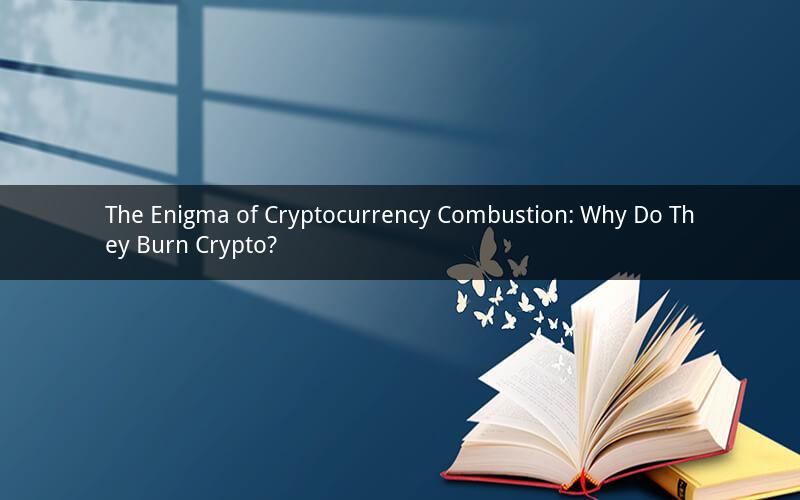
Introduction:
The world of cryptocurrencies has been abuzz with the phenomenon of burning crypto. As the value of digital assets continues to soar, many companies and investors have resorted to burning their tokens to enhance scarcity and potentially increase their value. This article delves into the reasons behind this trend and explores the potential implications of burning crypto.
1. What is Cryptocurrency Burning?
Cryptocurrency burning refers to the process of permanently removing a certain amount of cryptocurrency from circulation. This action is often carried out by companies that have issued their own tokens to reduce the total supply and create a sense of scarcity. By doing so, they aim to drive up the value of their tokens.
2. Why Do Companies Burn Crypto?
a. Enhancing Scarcity: As mentioned earlier, burning crypto helps in reducing the total supply, which in turn makes the remaining tokens more valuable. This scarcity can attract more investors and increase demand for the token.
b. Boosting Market Confidence: By burning their tokens, companies send a strong signal to the market that they are committed to maintaining the long-term value of their assets. This can help build trust and confidence among investors.
c. Differentiating from Other Tokens: In a highly competitive market, companies may burn their tokens to distinguish themselves from other cryptocurrencies. This can make their token more attractive to potential investors.
d. Fundraising: Some companies burn tokens as a way to raise funds. By offering a limited number of tokens at a higher price, they can generate more revenue.
3. The Impact of Cryptocurrency Burning
a. Potential Increase in Value: As mentioned earlier, burning crypto can lead to an increase in the value of the remaining tokens. This can benefit both the company and its investors.
b. Market Volatility: The act of burning crypto can cause short-term volatility in the market. Investors may react to the news of burning, leading to sudden price fluctuations.
c. Ethical Concerns: Critics argue that burning crypto can be seen as a way for companies to manipulate the market. This raises ethical concerns and questions about the long-term sustainability of the practice.
4. Examples of Companies That Have Burned Crypto
a. Tether: Tether, a stablecoin, has burned billions of its tokens over the years. They have done this to maintain the value of their stablecoin and ensure its stability.
b. Binance: Binance, one of the largest cryptocurrency exchanges, has burned millions of its BNB tokens. They have done this to enhance the value of their token and promote its use as a payment method.
c. Chainlink: Chainlink, a decentralized oracle network, has burned millions of its LINK tokens. They have done this to create a sense of scarcity and increase the value of the token.
5. Future of Cryptocurrency Burning
The future of cryptocurrency burning remains uncertain. While some companies have seen success with this strategy, others have faced criticism and regulatory scrutiny. Here are some potential future scenarios:
a. Increased Regulation: As the crypto market continues to grow, governments and regulators may impose stricter rules on cryptocurrency burning to prevent market manipulation.
b. Shift in Strategy: Companies may start to explore alternative methods of enhancing token value, such as improving the utility of their tokens or focusing on organic growth.
c. Continued Growth: Cryptocurrency burning may continue to be a popular strategy, especially among companies looking to differentiate themselves in a crowded market.
Conclusion:
The practice of burning crypto has gained significant attention in the cryptocurrency world. While it can have several benefits, such as enhancing scarcity and increasing token value, it also raises ethical and regulatory concerns. As the market evolves, it remains to be seen how cryptocurrency burning will impact the future of digital assets.
Additional Questions and Answers:
1. Question: Can burning crypto lead to inflation?
Answer: No, burning crypto actually reduces the total supply, which can lead to deflation rather than inflation.
2. Question: Is there a limit to how much crypto can be burned?
Answer: There is no strict limit to how much crypto can be burned, but it is generally considered a controversial practice, and the amount burned should be carefully managed.
3. Question: Can burning crypto affect the price of other cryptocurrencies?
Answer: Yes, burning crypto can have a ripple effect on the market, potentially affecting the prices of other cryptocurrencies due to increased demand and scarcity.
4. Question: Are there any negative consequences of burning crypto?
Answer: While burning crypto can have several benefits, it can also lead to market volatility and raise ethical concerns about market manipulation.
5. Question: Can burning crypto help prevent fraud in the cryptocurrency market?
Answer: Burning crypto can be a tool to prevent fraud by reducing the total supply and making it more difficult for fraudulent activities to occur, but it is not a foolproof solution.